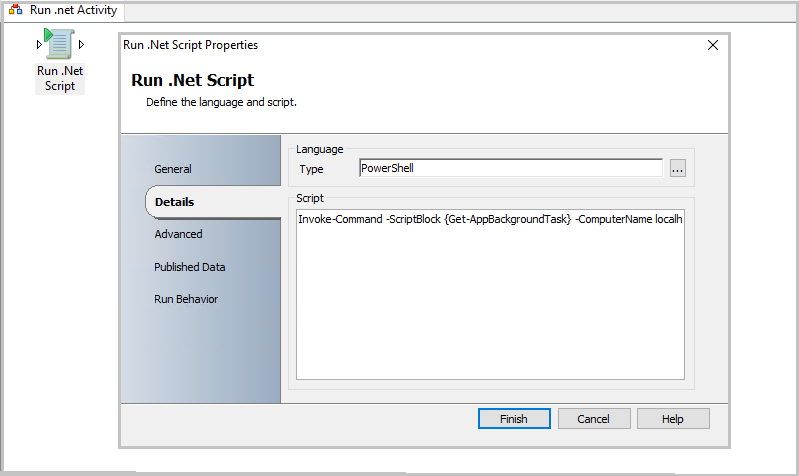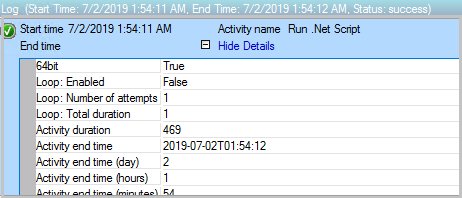Run .NET Script
The Run .NET Script activity runs scripts written in VB.NET, JScript, C#, and Windows PowerShell. This activity is compatible with .NET CLR version 2.0 and later. Use the Microsoft System Center - Orchestrator Run .NET Script activity to run scripts that parse data or run functions against available APIs.
Configure the Run .NET Script Activity
Before you configure the Run .NET Script activity, you need to determine the following:
The code you want to run.
The libraries you want to use.
The data you want to publish.
Use the following information to configure the Run .NET Script activity.
Note
You can't set individual security credentials for this activity. It will run under the service account configured for the Runbook Service on the Runbook server where the instance of the activity is running. This account must have the authority to access the resources and perform the actions required by this activity.
Details Tab
| Settings | Configuration Instructions |
|---|---|
| Type | Select the script language. Use the ellipsis button (...) to browse for the language. |
| Script | Enter the code that will run when the activity runs. |
Advanced Tab
| Settings | Configuration Instructions |
|---|---|
| Namespace | Add a Namespace for each .NET namespace that will be used within your code. This allows you to call the code without using fully qualified names for each of the classes. Orchestrator recommends adding System namespace to every Run .NET Script activity. |
| References | Add each of the Assembly (DLL) references that contain the libraries that you want to use. Add the System.dll located in the Windows\Microsoft.NET\Framework\<.NET Version> directory. |
Published Data
Add the published data items that you want this activity to publish. Every published data item that you add will be available on the Data bus. It's important to determine if a published data item will be multi-valued. The Run .NET Script activity automatically correlates multi-valued data from different items by aligning them. For example, if you choose to publish two items labeled Name and Email as Collections, the Run .NET script will try to line up each item in the Name collection with each item in the Email collection. If the collections aren't equally sized, then the Run .NET Script activity will create blank values for the collection that has fewer items. The following Published Data table lists the data items and the corresponding description published by this activity.
Published Data Tab
| Settings | Configuration Instructions |
|---|---|
| Name | Enter the Name of the published data. This will be the name that appears when other activities subscribe to the data published by the Run .NET Script activity. |
| Type | You can select Date/Time, Integer, or String. If the type you want isn't available, select String. Use the ToString method of the activity to assign a value to this published data. |
| Collection | If your data is multi-valued data, select Collection. When using a collection, you must use the Add method to add items to the collection. If you aren't using the collection, you can use the assignment operator (=) to assign the value. |
| Variable name | Use unique naming to ensure that your variable name does not collide with existing variables within your script or with classes and keywords available in .NET. We recommend prefixing variables with OPD_. For example, if you want to name your variable myString, you would name it OPD_myString. The Run .NET Script activity will automatically create a .NET Property for this item. If this variable is a collection, it will be created using a List<T>, where T is the Type that you selected. However, if it isn't a collection, the property will be created using a String, Integer, or Date/Time based on the Type that you selected. |
Published Data
| Item | Description |
|---|---|
| Standard Error | Any standard error output published by the Run .NET Script activity. |
| Namespaces | The namespaces used. |
| Standard Output | The standard output published by the Run .NET Script activity. |
| References | The Assemblies used in the activity. |
| Script Body | The script that was run. |
| Script Language | The language that was selected for the script. |
Execute 64-bit PowerShell cmdlets with Run .NET Script activity
You can run 64-bit Windows PowerShell in Orchestrator Run.Net Script activity. Use the following steps:
Create a Run .NET Script activity from the System activities group.
In Details > Type, select PowerShell as the language.
In Script, enclose your PowerShell commands in the following code:
Invoke-Command -ScriptBlock {YOUR CODE} -ComputerName localhostSelect Finish.

Note
To verify the PowerShell version, use the following script in Run .NET Script activity and publish the 64 bit and PowerShell version variable.
$Result = Invoke-Command -ComputerName localhost {
$Is64BitProcess = [Environment]::Is64BitProcess
$PSVersion = $PSVersionTable.PSVersion
RETURN $Is64BitProcess, $PSVersion
}
$64bit = $Result[0]
$PSVersion = $Result[1]
